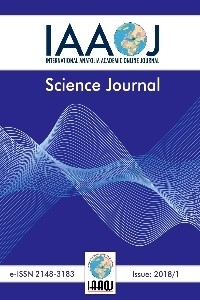Usage of Detoxification Enzyme Glutathione-S-Transferases over Galleria mellonella L. (Lepidoptera: Pyralidae) as Biomarkers of Insecticide Resistance
Insecticides are preferred because of their easy applicability in combating pest insects and their short-term results. Insecticides used over dose and unconsciously in agricultural areas cause ecological damage. Also; the use of over dose insecticides in agricultural areas has led to the development of insect resistance. Since the resistance mechanism developed is genetic, it is transmitted to later fertilizers. For this reason, it is important to apply the insecticides in the restricted areas and in the optimal amount. Insects increase their detoxification capacities to protected themselves from insecticides. Detoxification mechanisms are based on the breakdown of insecticides before reaching the target area. The most important detoxification enzyme in insects are Glutathion-S-Transferases (GST). GST enzyme in insects has a role in protection of cellular membranes against oxidative degradation as well as detoxification mechanism. Galleria mellonella may be used as a model organism for understanding the insecticide resistance mechanism.
Anahtar Kelimeler:
Galleria mellonella, detoxification, oxidation, antioxidant, toxicology
Usage of Detoxification Enzyme Glutathione-S-Transferases over Galleria mellonella L. (Lepidoptera: Pyralidae) as Biomarkers of Insecticide Resistance
Insecticides are preferred because of their easy applicability in combating pest insects and their short-term results. Insecticides used over dose and unconsciously in agricultural areas cause ecological damage. Also; the use of over dose insecticides in agricultural areas has led to the development of insect resistance. Since the resistance mechanism developed is genetic, it is transmitted to later fertilizers. For this reason, it is important to apply the insecticides in the restricted areas and in the optimal amount. Insects increase their detoxification capacities to protected themselves from insecticides. Detoxification mechanisms are based on the breakdown of insecticides before reaching the target area. The most important detoxification enzyme in insects are Glutathion-S-Transferases (GST). GST enzyme in insects has a role in protection of cellular membranes against oxidative degradation as well as detoxification mechanism. Galleria mellonella may be used as a model organism for understanding the insecticide resistance mechanism.
Keywords:
Galleria mellonella, detoxification, oxidation, antioxidant, toxicology,
___
- Beck, S D (1960) Arts,Growth and Development of the Greater Wax Moth, Galleria mellonella (L.) (Lepitoptera: Galleriidae) ,Wisconsin Academy of Sciences s. 49,137-149.
- Bronskıll J (1961) A Cage to Simplify the Rearing of the Greater Wax Moth, Galleria mellonella (Pyralidae). J. Lep.Soc.,Vol. 15, No 2, s. 102-104.
- Büyükgüzel, E., Büyükgüzel, K., Adamski, Z., Marciniak, P., Ventrella, E., Bufo, A., Erdem, M., Ziemnicki, K. (2013). The influence of diatery α-solanine on the waxmoth Galleria mellonella. Arch. Insect. Biochem. Physiol. 0:1-10
- Büyükgüzel E., Kalender, Y. (2009). Exposure to streptomycin alters oxidative and antioxidative response in larval midgut tissues of Galleria mellonella. Pestic. Biochem. Physiol. 94: 112-118.
- Büyükgüzel, K. (2001). DNA gyrase inhibitors: Novobiocin enhances the survival of Pimpla turionellae larvae reared on an artificial diet but other antibiotics do not. J. Appl. Entomol. 125: 583-587.
- Cetin H, Demir E, Kocaoglu S, Kaya B (2010. Insecticidal Activity of Some Synthetic Pyrethroids with Different Rates of Piperonyl Butoxide (PBO) Combinations on Drosophila melanogaster (Diptera: Drosophilidae). Ekoloji 19 (75): 27-32.
- Hollingworth, R.M. and K. Dong, (2008). The Biochemical and Molecular Genetic Basis of Resistance to Pesticides in Arthropods. (Global Pesticide Resistance in Arthropods, Ed: Whalaon, M.E., Mota-Sanchez, D. And Hollingworth, R.M.), 40-90, Cromwell, UK.
- House H L (1972) Insect Nutrition, In Biology of Nutrition, Ed by T-W-Fiennes, R.N.Pergamon Press,Oxford ,513-575.
- İçen E (2003) Antiviral ajan asiklovirin büyük bal mumu güvesi Galleria mellonella L. (Lepidoptera: Pyralidae) ‘ nın büyüme, yaşama ve gelişimine etkisi. Yüksek lisans tezi, Zonguldak Karaelmas Üniversitesi, Fen Bilimleri Enstitüsü, Zonguldak.
- Konanz, S. and R. Nauen, (2004). Purification and Partial Characetrization of a Glutathione-S-transferase from the Two-spotted Spider Mite, Tetranychus urticae. Pesticide Biochemistry and Physiology, 79(2): 49-57.
- Kranthi, K. R, (2005). Insecticide Resistance Monitoring, Mechanisms and Management Manual. Central Institute for Cotton Research 51-87.
- Miller F, Uetz S (1998) Evaluating Biorational Pesticides for Controlling Arthropod Pests and Their Phytotoxic Effects on Greenhouse Crops. HortTechnology 8 (2): 185-192.
- Özer C (2011) Subletal Dozlardaki Diazinon’un Galleria mellonella L.’nın Bazı Biyokimyasal Parametrelerine Etkileri, Adana, Çukurova Üniversitesi.
- Sertçelik M., Sugeçti S., Büyükgüzel E., Necefoğlu H., Büyükgüzel K. (2018). Toxicological and Physiological Effects of Diaquabis(N,N-diethylnicotinamide-x N1)bis(4-formylbenzoato- x O)cobalt(II) complex on Galleria mellonella L. (Lepidoptera: Pyralidae) as a model organism. Karaelmas Fen ve Müh. Derg. 359-364.
- Soderlund D. M. (1997). Molecular Mechanisms of Insecticide Resistance. (Molecular Mechanisms of Resistance to Agrochemicals, Volume Ed: Sjut, V., Chemistry of Plant Protection, Ed: Ebing, V.), Vol: 13, 21-73, Springer Germany.
- Sugeçti S., Büyükgüzel E., Büyükgüzel K. (2016). Laboratory Assays of the Effects of Oxfendazole on Biological Parameters of Galleria mellonella (Lepidoptera: Pyralidae). J. Entomol. Sci. 51 (2): 129-137.
- Sugeçti S., Çelik C., Büyükgüzel E., Büyükgüzel K. (2017). Biochemical Damage and Immuno-physiological Adaptation on Model Organism Galleria mellonella L. (Lepidoptera: Pyralidae) Larvae Exposed to Clinical Pathogen, Klebsiella oxytoca, XIII. Uluslararası Katılımlı Ekoloji ve Çevre Kongresi, s 483, Edirne.
- Susurluk H. (2008). İki benekli Kırmızıörümcek Tetranychus urticae Koch (Acarina:Tetranychidae)’de Piretroid İnsektisitlere Karşı Oluşan Direncin Moleküler Karakterizasyonu. Ankara Üniversitesi Fen Bilimleri Enstitüsü Doktora Tezi.
- Uckan F, Sak O (2010) Cytotoxic Effect of Cypermethrin on Pimpla turionellae (Hymenoptera: Ichneumonidae) Larval Hemocytes. Ekoloji 19 (75): 20-26.
- Vınson S B (1976) Host Selection by Insect Parasitoids, Ann. Entomol., S.21, 109–133.
- Vınson S B (1981) Semiochemicals, their Role in Pest Control Ed by W. J. Bell and R. T. Carde, Habitat S. 51–77.
- Yorulmaz S and Ay R (2010). Akar ve Böceklerde Pestisitlerin Detoksifikasyonunda Rol Oynayan Enzimler. Journal of Agricultural Faculty of Uludag University, 24(2):137-148.
- Yu, S. J. (2008). The Toxicology and Biochemistry of Insecticides. CRC Pres Taylor Francis Group, 250 pp.
- Başlangıç: 2013
- Yayıncı: Abdülkadir IŞIK
